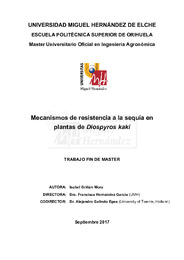Por favor, use este identificador para citar o enlazar este ítem:
https://hdl.handle.net/11000/3967Registro completo de metadatos
| Campo DC | Valor | Lengua/Idioma |
|---|---|---|
| dc.contributor.advisor | Hernández García, Francisca | - |
| dc.contributor.advisor | Galindo Egea, Alejandro | - |
| dc.contributor.author | Griñán Mora, Isabel | - |
| dc.date.accessioned | 2017-09-27T15:34:38Z | - |
| dc.date.available | 2017-09-27T15:34:38Z | - |
| dc.date.created | 2017-09 | - |
| dc.date.issued | 2017-09-27 | - |
| dc.identifier.uri | http://hdl.handle.net/11000/3967 | - |
| dc.description.abstract | El objetivo del presente trabajo se centra en el estudio de las relaciones hídricas en plantas de caqui (Diospyros kaki L.f.) a fin de determinar los mecanismos de resistencia (evitación y tolerancia) a la sequía. Para ello, se utilizó una plantación de árboles de la variedad Rojo Brillante sita en Alquerías (Murcia) con tres tratamientos de riego. Un tratamiento control (T0), regado por encima de la ETc a fin de conseguir condiciones no limitantes de agua en el suelo, un tratamiento T1, regado según los criterios del agricultor y otro tratamiento (T2) al que se le suprimió el riego durante 5 semanas, regándose posteriormente como el T0 a fin de recuperar el estado hídrico. Los resultados obtenidos indicaron que las plantas de caqui afrontan situaciones de déficit hídrico suave esencialmente con el desarrollo de un mecanismo de evitación del estrés, no desarrollando ningún mecanismo de tolerancia al déficit hídrico. En este sentido, la conductancia foliar demostró una muy alta sensibilidad al déficit hídrico, disminuyendo de forma muy precoz para controlar las pérdidas de agua vía transpiración y evitar la pérdida de la turgencia celular. Complementariamente, debe mencionarse que los altos niveles de agua apoplástica pueden considerarse como una característica xeromórfica de estas plantas. | es |
| dc.description.abstract | No information exists on the mechanisms developed at the level of leaf water relations by persimmon trees (Diospyros kaki L.f.) to confront drought. For this reason, the purpose of the present study was to analyse its leaf water relations in order to clarify the resistance mechanisms (avoidance and tolerance) developed in response to a water stress and during recovery. Field-grown 3-year-old pear-jujube trees (cv. Rojo Brillante) were subjected to three irrigation treatments. Control (T0) plants were drip irrigated (112% ETo) in order to guarantee non-limiting soil water conditions, T1 plants were drip irrigated according to the criteria used by the grower and T2 plants irrigated as T0 but subjected to water withholding for 34 days and a subsequent re-irrigation at the levels used in T0 for 15 days, during the summer of 2016. The results indicated that persimmon plants do not develop tolerance mechanisms (osmotic adjustment and elastic adjustment) to confront mild water stress. However, they develop stress avoidance mechanisms. From the beginning of water deficit, leaf conductance and the duration of maximum stomatal opening in water stressed plants decreased, avoiding leaf turgor lost. Also, the gradual recovery of gl observed after rewatering the plants can be considered as a mechanism for promoting leaf rehydration. The high leaf apoplastic water content levels can be considered another drought resistance characteristic in persimmon plants because so it can support a steeper gradient in water potential between the leaf and the soil. | es |
| dc.format | application/pdf | es |
| dc.format.extent | 55 | es |
| dc.language.iso | spa | es |
| dc.rights | info:eu-repo/semantics/openAccess | es |
| dc.subject | Caquis | es |
| dc.subject | Estrés hídrico | es |
| dc.subject.other | CDU::6 - Ciencias aplicadas::63 - Agricultura. Silvicultura. Zootecnia. Caza. Pesca::634 - Horticultura. Viticultura | es |
| dc.title | Mecanismos de resistencia a la sequía en plantas Diospyros Kaki | es |
| dc.type | info:eu-repo/semantics/masterThesis | es |

Ver/Abrir:
TFM Griñán Mora, Isabel.pdf
3,86 MB
Adobe PDF
Compartir:
 La licencia se describe como: Atribución-NonComercial-NoDerivada 4.0 Internacional.
La licencia se describe como: Atribución-NonComercial-NoDerivada 4.0 Internacional.
.png)